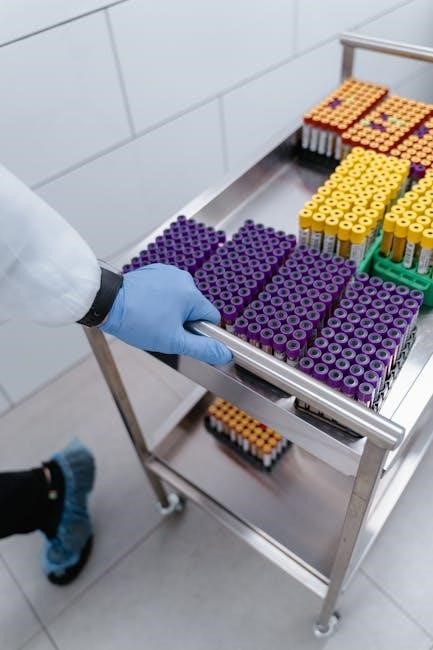This comprehensive study guide is designed to help aspiring sterile processing technicians master essential skills and knowledge. It covers key topics, including certification requirements, core concepts, and exam preparation strategies, ensuring a thorough understanding of the field. With practice tests and detailed explanations, it serves as an invaluable resource for achieving certification and excelling in this critical healthcare role.
1.1 Overview of the Role and Responsibilities
A sterile processing technician plays a critical role in healthcare by ensuring medical instruments are properly sterilized and prepared for safe patient care. Their primary responsibilities include decontaminating soiled instruments, inspecting equipment for damage, and packaging items for sterilization. They must adhere to strict infection control protocols to prevent contamination and maintain patient safety. Additionally, technicians are responsible for operating sterilization equipment, monitoring sterilization cycles, and maintaining accurate records. Their work is essential to the smooth operation of healthcare facilities, as they ensure the availability of sterile supplies for surgical and medical procedures. Proper training and certification are vital to perform these duties effectively and efficiently.
1.2 Importance of Certification
Certification is crucial for sterile processing technicians as it validates their expertise and commitment to patient safety. The CRCST (Certified Registered Central Service Technician) and CSPDT (Certified Sterile Processing and Distribution Technician) credentials demonstrate a technician’s ability to follow strict infection control protocols and operate specialized equipment. Employers often require certification to ensure compliance with industry standards and regulatory requirements. Certification also enhances career opportunities, as it signifies a higher level of professionalism and competence. By obtaining certification, technicians contribute to reducing risks of infection and ensuring the safe preparation of medical instruments, ultimately protecting patient health and advancing the quality of healthcare services.
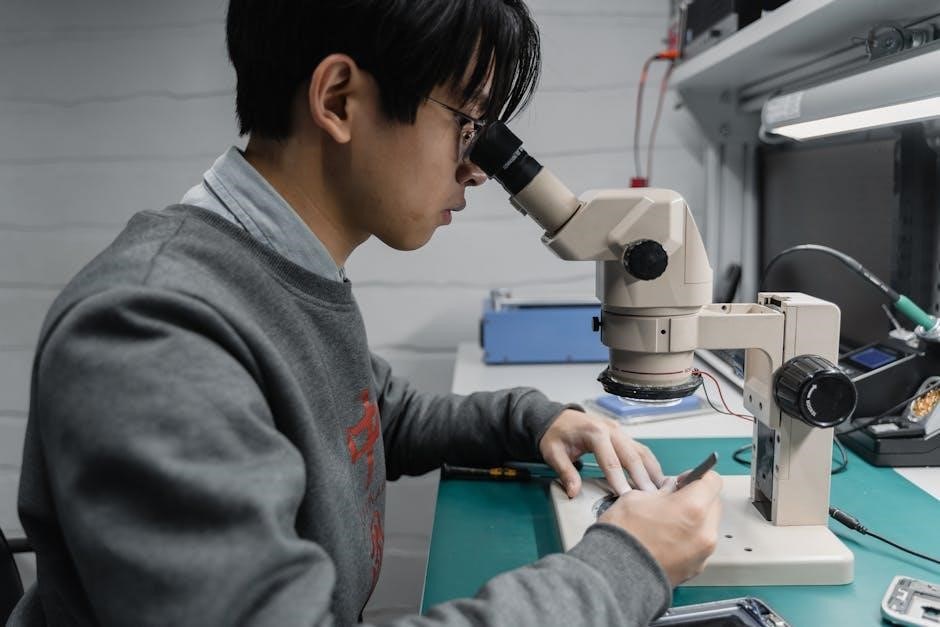
Key Areas of Study for the CRCST Certification
The CRCST certification focuses on mastering sterilization methods, infection control, and central service workflows. It also covers instrument preparation, quality assurance, and anatomy basics to ensure comprehensive understanding.
2.1 Understanding the Certified Registered Central Service Technician (CRCST) Exam
The Certified Registered Central Service Technician (CRCST) exam, administered by the Healthcare Sterile Processing Association (HSPA), is a critical step in becoming a certified sterile processing technician. This exam assesses a technician’s knowledge and competency in key areas such as sterilization methods, infection control, and central service workflows. It consists of multiple-choice questions designed to evaluate understanding of core concepts and practical applications. The exam format and content are outlined in study guides and resources, which are essential for effective preparation. Passing the CRCST exam demonstrates a technician’s ability to provide safe and effective sterilization services in healthcare settings, making it a cornerstone of professional certification in this field.
2.2 Core Concepts in Sterile Processing
Sterile processing involves critical concepts that ensure patient safety and prevent infection. Key areas include understanding sterilization methods, such as autoclaving and hydrogen peroxide gas plasma, and their applications. Infection control principles, including proper use of personal protective equipment (PPE) and hand hygiene, are fundamental. The one-way workflow—decontamination, preparation, packaging, sterilization, and storage—ensures instruments are processed safely and efficiently. Quality control measures, such as biological and chemical monitoring, are essential to verify sterilization effectiveness. These concepts form the foundation of sterile processing, ensuring that medical instruments are safe for patient use and reducing the risk of healthcare-associated infections.
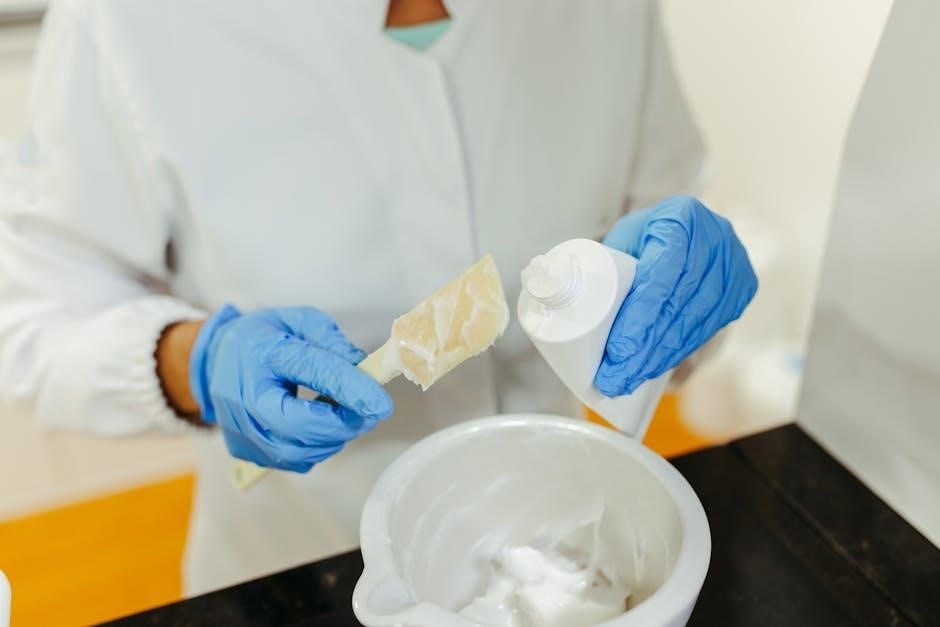
Sterilization and Disinfection Principles
Sterilization eliminates all microbial life, while disinfection reduces pathogens. These principles are critical in preventing infections and ensuring patient safety. Proper application of these methods guarantees safe instrument use.
3.1 Types of Sterilization Methods
Sterilization methods are critical for ensuring the elimination of all microbial life. Common techniques include steam sterilization, widely used in autoclaves for heat-resistant instruments. Hydrogen peroxide gas/plasma sterilization is ideal for heat-sensitive equipment, offering effective microbial kill without damaging materials. Ethylene oxide sterilization is used for critical items that cannot withstand high temperatures, though it requires longer cycles. Dry heat sterilization is suitable for non-moisture-sensitive items, using high temperatures over time. Each method has specific applications, and understanding their principles ensures proper instrument processing and patient safety. Technicians must master these techniques to maintain sterility and prevent infections in healthcare settings.
3.2 Infection Control and Prevention
Infection control and prevention are cornerstone principles in sterile processing. Proper hand hygiene, use of personal protective equipment (PPE), and adherence to standard precautions are essential to minimize the spread of pathogens. Surface disinfection and sterilization of equipment play critical roles in maintaining a safe environment. Understanding the chain of infection and implementing effective barriers are key strategies. Technicians must also manage medical waste appropriately to prevent contamination. These practices not only protect patients but also ensure the safety of healthcare workers. Continuous education and compliance with infection control guidelines are vital to uphold high standards of patient care and public health safety.

Central Service One Way Work Flow
The Central Service One Way Work Flow ensures efficient and safe processing of medical instruments. It involves three key stages: decontamination (soiled area), preparation, packaging, and sterilization (clean area), and sterile storage and distribution. This workflow prevents cross-contamination and maintains instrument sterility, critical for patient safety and infection control. Proper execution of this process is essential for healthcare facilities to operate effectively and comply with regulatory standards.
4.1 Decontamination Process
The decontamination process is the initial step in the Central Service workflow, ensuring all soiled instruments are safely cleaned and prepared for further processing. This critical phase involves removing organic material, such as blood and tissue, through manual or mechanical cleaning, followed by disinfection. Proper use of personal protective equipment (PPE) is essential to protect staff from potential biohazards. Instruments are sorted and inspected for damage or residual contamination before being transferred to the clean area for packaging and sterilization. Effective decontamination is vital to prevent infection transmission and ensure instruments are ready for safe reuse. This step is fundamental in maintaining patient safety and operational efficiency in healthcare settings.
4.2 Preparation, Packaging, and Sterilization
After decontamination, instruments undergo preparation and packaging to ensure they are ready for sterilization. This step involves cleaning, inspecting, and assembling instruments into sets or trays. Packaging materials, such as wraps or containers, are used to maintain sterility during and after the process. Sterilization methods, such as steam, hydrogen peroxide, or ethylene oxide, are applied based on instrument compatibility. Proper packaging ensures that sterilization agents can penetrate effectively. Once sterilized, items are sealed in a way that prevents re-contamination. This phase is critical for maintaining the integrity of sterile supplies, ensuring patient safety, and adhering to infection control standards. Accurate preparation and packaging are vital to the success of the sterilization process.
4.3 Sterile Storage and Distribution
After sterilization, items must be stored in a manner that maintains their sterility. This involves placing them in clean, dry environments with controlled temperature and humidity. Shelving should be off the floor to prevent moisture exposure, and items should be organized to avoid damage. Packaging materials, such as plastic wrap or sterilization containers, are crucial for protecting items during storage. Labels indicating sterilization dates are essential for tracking and ensuring items are used before expiration. Distribution requires careful handling to prevent contamination, using covered carts or enclosed transport systems. Only authorized personnel should handle sterile supplies, and they must be delivered to clinical areas in a way that maintains sterility throughout the process.

Anatomy and Physiology Basics
This section provides foundational knowledge of human anatomy and physiology, essential for understanding instrument usage and pathogen control, ensuring effective sterile processing and infection prevention practices.
5.1 Importance of Anatomy in Sterile Processing
Understanding anatomy is crucial for sterile processing technicians, as it helps identify where medical instruments are used and how they interact with the human body. This knowledge ensures proper handling, cleaning, and sterilization of instruments, reducing the risk of damage or contamination. Familiarity with anatomical structures also aids in recognizing instrument types and their specific functions, which is essential for maintaining patient safety and preventing infections. By linking anatomy to sterile processing practices, technicians can better navigate the workflow, from decontamination to sterilization, ensuring instruments are prepared correctly for surgical and medical procedures. This expertise is vital for upholding quality and safety standards in healthcare settings.
5.2 Physiology of Pathogens and Their Control
Understanding the physiology of pathogens is essential for sterile processing technicians to effectively prevent infections and maintain sterility. Pathogens, such as bacteria, viruses, and fungi, have unique survival mechanisms, like spore formation or biofilm production, which can resist standard disinfection methods. Knowledge of their life cycles and growth requirements enables technicians to apply appropriate sterilization and disinfection techniques. For example, autoclaving is effective against heat-resistant spores, while chemical disinfectants target vegetative cells. By understanding pathogen physiology, technicians can ensure the use of correct methods to eliminate microbial threats, critical for patient safety and infection control in healthcare settings. This knowledge is vital for maintaining the highest standards of sterilization and preventing the spread of infections.

Instrumentation and Equipment
Understanding medical instruments and equipment is crucial for sterile processing. This section covers types of instruments, their uses, and equipment like autoclaves and ultrasonic cleaners, ensuring proper sterilization techniques are applied effectively.
6.1 Types of Medical Instruments and Their Uses
Medical instruments in sterile processing include surgical, dental, and diagnostic tools. Surgical instruments like scalpels, forceps, and retractors are used in procedures. Dental instruments, such as drills and mirrors, are specific to oral care. Diagnostic tools like endoscopes and thermometers aid in patient assessment. Understanding each instrument’s purpose ensures proper handling, cleaning, and sterilization. For example, orthopedic instruments require meticulous care due to their complexity, while ophthalmology tools demand precision to maintain their delicate structures. Familiarity with materials, such as stainless steel or plastic, also guides appropriate sterilization methods. This knowledge is essential for technicians to ensure instruments remain functional and safe for patient use.
6.2 Equipment Used in Sterile Processing Departments
Sterile processing departments utilize specialized equipment to ensure effective sterilization and maintenance of medical instruments. Key equipment includes autoclaves for steam sterilization, ethylene oxide sterilizers for heat-sensitive items, and ultrasonic cleaners for removing debris. Washers and dryers specifically designed for medical instruments are also essential. Packaging equipment, such as heat sealers and sterilization validators, ensures items are properly prepared for sterilization. Additionally, storage systems like shelving and cabinets maintain sterility and organization. Automated tracking systems help monitor instrument usage and sterilization cycles. Each piece of equipment plays a critical role in maintaining patient safety and operational efficiency within the SPD, requiring technicians to be well-versed in their operation and maintenance.
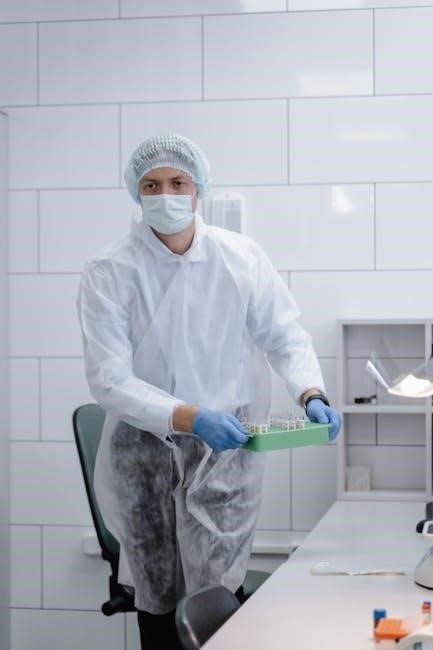
Preparation and Packaging of Instruments
Proper preparation and packaging of instruments are critical to maintaining sterility. This involves cleaning, inspecting, and placing items in appropriate packaging materials to prevent contamination during sterilization and storage.
7.1 Proper Techniques for Instrument Preparation
Proper techniques for instrument preparation are essential to ensure sterility and functionality. Instruments must be cleaned thoroughly, with attention to all surfaces, crevices, and lumens, using ultrasonic cleaners or manual scrubbing. Lubrication of movable parts prevents rust and ensures proper function. Instruments should be dried completely to avoid moisture, which can lead to contamination. Organizing and arranging instruments in a logical order, such as grouping similar items, facilitates efficient packaging and sterilization. Inspection for damage or wear is critical before packaging. Proper preparation ensures instruments remain sterile throughout the process and are ready for safe use in patient care.
7.2 Packaging Materials and Methods
Packaging materials and methods are critical to maintaining sterility during transportation and storage. Common materials include disposable wraps, rigid containers, and peel pouches. Instruments must be packaged in a way that prevents contamination and ensures sterility is maintained. Double packaging is often used for items that will be stored for extended periods. Chemical indicators or biological markers are included to confirm sterilization success. Proper sealing techniques, such as using heat seals or adhesive strips, are essential. Packaging should allow for easy opening without compromising sterility. Following standardized protocols ensures consistency and safety in the sterilization process, ultimately protecting patient health and maintaining infection control standards.
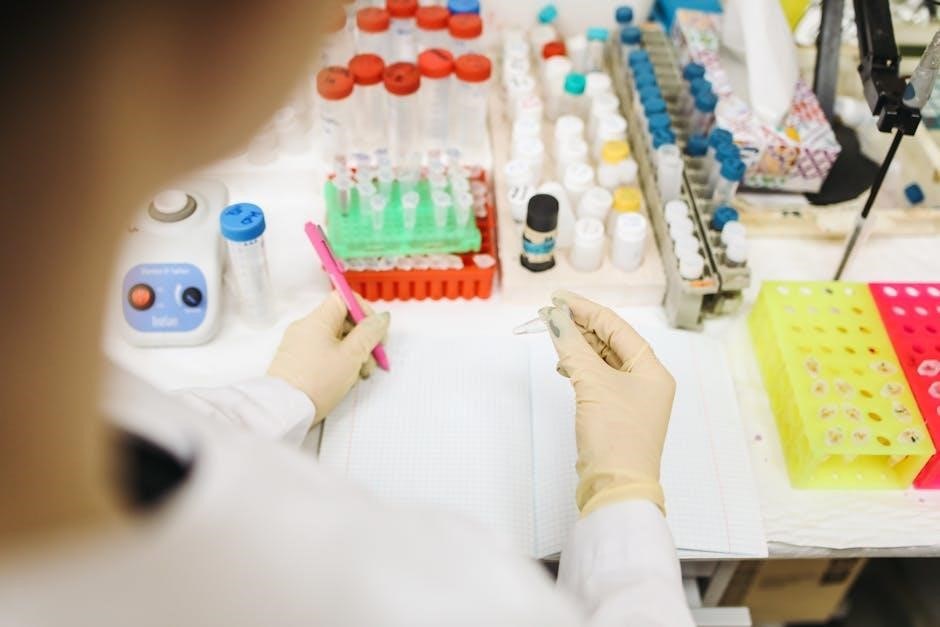
Sterile Storage and Handling
Maintaining sterility is crucial during storage and handling. Use secure, dry storage areas with controlled access. Handle sterile items gently to prevent damage or contamination. Ensure proper labeling and dating of stored supplies. Transport sterile items in covered containers to prevent exposure to contaminants. Regularly inspect stored items for signs of compromise. Follow facility protocols for shelf life and rotation of sterile goods. Proper storage and handling ensure patient safety and infection control. Always verify sterility before use through visual inspection and documentation. Adhere to guidelines to maintain the integrity of sterile supplies.
8.1 Maintaining Sterility in Storage
Maintaining sterility in storage requires meticulous attention to detail and adherence to established protocols; Store sterile items in a clean, dry, and secure environment, ensuring they are protected from moisture, dust, and contamination. Use appropriate packaging materials, such as sealed containers or wraps, to prevent exposure. Label and date all stored items clearly to ensure proper rotation and use. Avoid overcrowding storage areas to prevent accidental damage. Regularly inspect stored supplies for signs of compromise, such as torn packaging or visible contamination. Implement environmental monitoring to detect potential risks. Train staff on proper storage practices to uphold sterility. Follow facility-specific guidelines for shelf life and storage conditions to ensure patient safety and compliance with infection control standards.
8.2 Handling and Transportation of Sterile Supplies
Proper handling and transportation of sterile supplies are critical to maintaining their sterility. Always use enclosed containers or sealed bags to transport items, ensuring they remain untouched and protected from contamination. Avoid touching sterile areas or allowing supplies to come into contact with non-sterile surfaces. Use clean, covered carts or containers for transport, and handle supplies gently to prevent movement that could compromise sterility. Label all items clearly, including their contents and sterilization dates, to ensure proper identification and use. Train staff to follow established protocols for handling and transporting sterile supplies, emphasizing the importance of maintaining sterility throughout the process. This ensures patient safety and compliance with infection control guidelines.
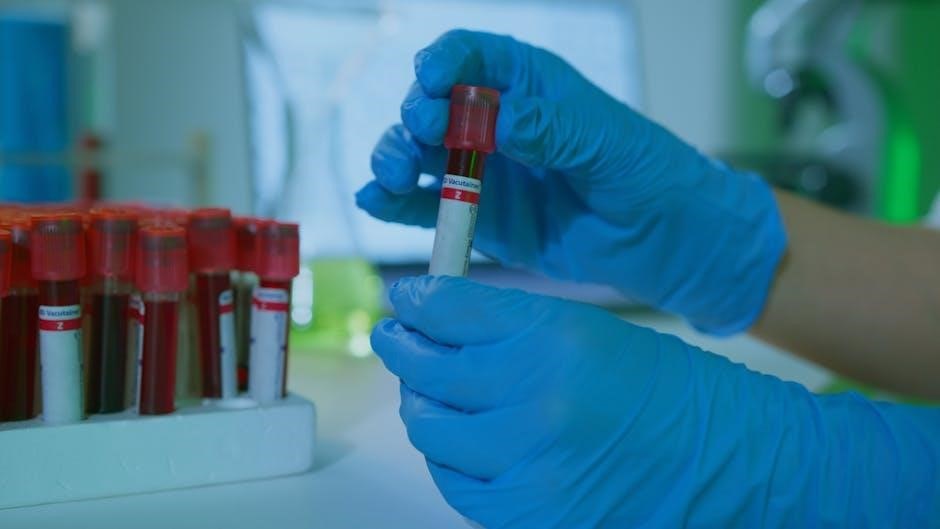
Quality Control and Assurance
Quality control ensures all sterilized supplies meet strict standards, while quality assurance monitors processes to maintain consistency and compliance with industry guidelines, safeguarding patient safety and operational integrity.
9.1 Monitoring and Maintaining Quality Standards
Monitoring and maintaining quality standards in sterile processing are critical to ensuring the safety and effectiveness of medical instruments. This involves regular testing and inspection of sterilized equipment to confirm sterility and functionality. Biological, chemical, and mechanical indicators are commonly used to verify the success of sterilization processes. Additionally, maintaining detailed documentation of quality control activities helps track compliance with industry standards and regulations. Ongoing training and audits further support the consistency of high-quality outcomes. By adhering to these practices, sterile processing departments can minimize risks and ensure that all supplies meet the required safety and efficacy criteria for patient care and operational excellence.
9.2 Documentation and Record-Keeping
Accurate documentation and record-keeping are essential in sterile processing to ensure compliance with regulatory standards and maintain patient safety. Detailed records of sterilization cycles, equipment maintenance, and biological testing must be kept for traceability and audit purposes. These records help track the history of instruments and confirm their readiness for use. Proper documentation also supports quality control processes and provides evidence of adherence to industry guidelines. Additionally, maintaining clear and organized records facilitates communication among healthcare teams and ensures continuity in care. Regular reviews and updates to documentation systems are necessary to maintain accuracy and efficiency, ensuring that all information is accessible and up-to-date for healthcare professionals.
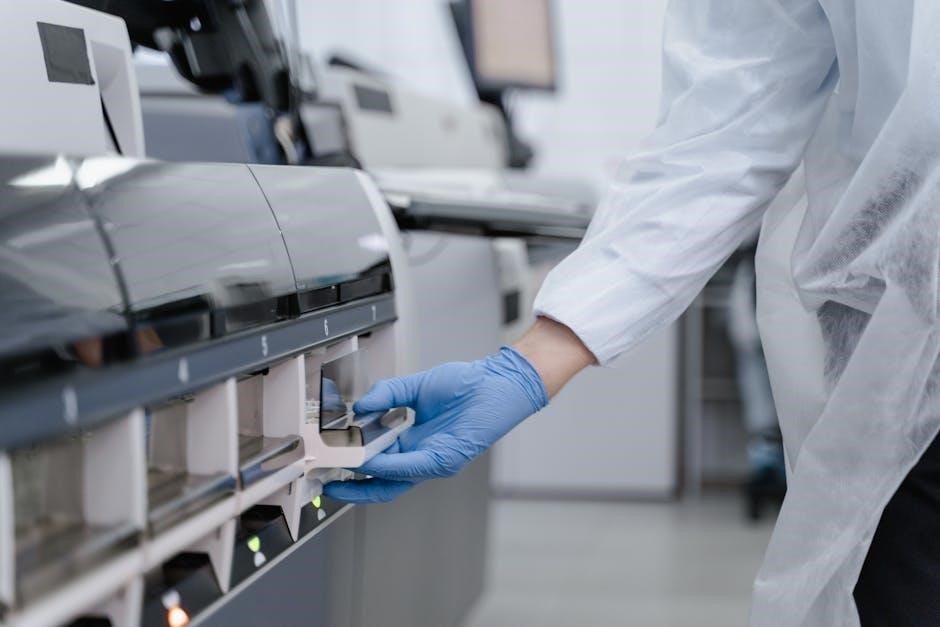
Exam Preparation and Practice Tests
Effective exam preparation involves utilizing practice tests and study guides to assess knowledge and identify areas for improvement. These resources provide realistic exam simulations, enhancing test-taking skills and confidence.
10.1 Tips for Effective Study and Exam Preparation
Effective study begins with a structured plan, focusing on key areas like anatomy, sterilization methods, and infection control. Utilize active learning techniques, such as flashcards, to reinforce memory. Practice tests are crucial for identifying weaknesses and improving time management. Dedicate time to review incorrect answers, ensuring a thorough understanding. Prioritize topics covered in the sterile processing technician study guide PDF, as they align with exam content. Incorporate regular breaks to maintain focus and avoid burnout. Leverage online resources, including video tutorials and study groups, to enhance learning. Consistency and self-assessment are key to achieving certification success.
10.2 Utilizing Practice Tests and Study Guides
Practice tests and study guides are essential tools for exam preparation. They provide hands-on experience with the exam format and content, helping to identify strengths and areas for improvement. Utilize the sterile processing technician study guide PDF to access retired test questions and detailed explanations. Websites like Nimble Prep offer free and paid practice questions, while platforms like Quizlet provide flashcards for key terms. Regularly taking timed practice tests improves time management and reduces exam-day anxiety. Reviewing incorrect answers and understanding the reasoning behind them is crucial for long-term retention. Combining these resources with structured study sessions ensures a comprehensive understanding of the material and boosts confidence for the certification exam.
Career Advancement and Professional Development
Career advancement in sterile processing involves pursuing advanced certifications, such as CSPDT or CIS, and staying updated on industry standards. Professional development through continuing education and workshops enhances skills and knowledge, opening doors to leadership roles. Networking with peers and joining professional organizations like HSPA or CBSPD provides access to resources, mentorship, and job opportunities. Specializing in areas like infection control or equipment management can further boost career prospects. Regularly reviewing the sterile processing technician study guide PDF and participating in online forums ensures lifelong learning and adaptability in this evolving field.
11.1 Opportunities for Growth in Sterile Processing
Career growth in sterile processing is abundant, with opportunities to advance into specialized roles like infection control specialist or sterile processing supervisor. Technicians can pursue advanced certifications such as CSPDT or CIS, enhancing their expertise and marketability. Leadership roles, such as lead technician or department manager, offer higher responsibility and compensation. Additionally, professionals can transition into education or consulting, sharing their knowledge with others. Staying updated on industry standards and participating in professional organizations like HSPA or CBSPD further expands networking and advancement possibilities. The field’s constant evolution ensures that skilled and dedicated individuals can continually grow and thrive in their careers.
11.2 Importance of Continuing Education
Continuing education is essential for sterile processing technicians to stay updated on industry standards, advanced techniques, and new technologies. The healthcare field evolves rapidly, and ongoing training ensures technicians remain proficient in infection control, sterilization methods, and equipment operation. Professional certifications like CRCST or CSPDT often require continuing education credits for renewal, demonstrating a commitment to professional growth. Additionally, staying informed about regulatory changes and best practices enhances patient safety and workplace efficiency. Engaging in workshops, webinars, and courses offered by organizations like HSPA or CBSPD helps technicians adapt to emerging challenges, ensuring they deliver high-quality care and maintain their competitive edge in the field.
